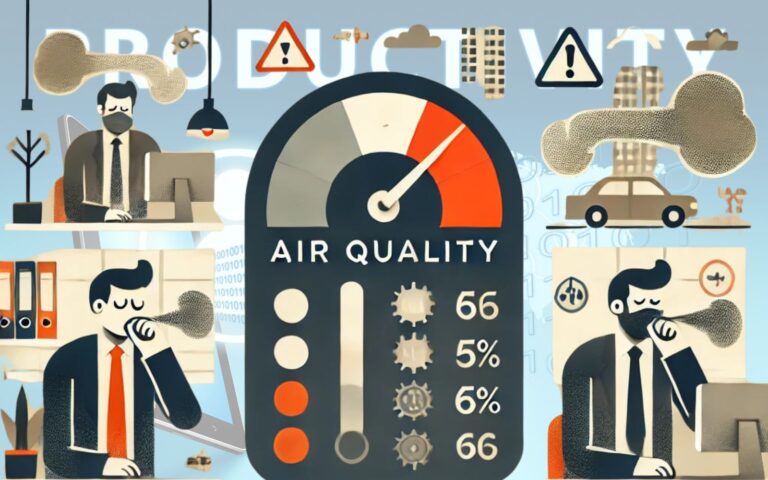Impact of Air Quality on Health: Understanding the Risks and Solutions

The impact of air quality on health is a growing concern worldwide. Poor air quality is linked to a range of health problems, from respiratory disease and lung disease to cardiovascular disease and even Alzheimer’s disease.
Air pollution exposure affects human health at all stages of life, increasing the risk of chronic diseases, lung cancer, and premature death.
The World Health Organization (WHO) has classified air pollution as a significant threat to public health.
Whether it’s outdoor air pollution from industrial emissions, fossil fuels, and wildfire smoke or indoor pollution from natural gas and volatile organic compounds (VOCs), the health impacts are undeniable.
In this article, we’ll explore how air pollutants affect your body, the most significant sources of pollution levels, and what you can do to reduce air pollution and protect yourself.
Key Takeaways
- Air pollution increases the risk of chronic obstructive pulmonary disease (COPD), asthma attacks, and lung infections.
- Long-term exposure to particulate matter (PM), nitrogen oxides (NOx), and sulfur oxides (SOx) contributes to the development of heart disease, reduced lung function, and systemic inflammation.
- Particulate matter (PM2.5) and carbon monoxide (CO) increase the risk of emergency department visits and mortality.
- Prenatal exposure to ambient air pollution can lead to low birth weight and adverse birth outcomes.
- Older adults and those with underlying health conditions are at an increased risk of complications from exposure to air pollution.
- Improving air quality through policies such as the Clean Air Act, cleaner energy sources, and pollution control can help protect public health.
How Air Pollution Affects Your Health

1. Respiratory Health and Lung Diseases
Poor air quality is a significant contributor to respiratory infections, asthma prevalence, and the development of lung and heart disease. Exposure to air pollution can cause:
- Chronic obstructive pulmonary disease (COPD) – A progressive disease that makes breathing difficult.
- Asthma attacks – Air pollutants like nitrogen dioxide (NO2) and particulate matter PM can trigger asthma attacks.
- Lung tissue damage – Chronic exposure to pollution can reduce lung development in children.
- Respiratory infections – High pollution levels increase the likelihood of pneumonia, bronchitis, and other lung infections.
2. Cardiovascular Disease and Heart Problems
Air pollution exposure is directly linked to an increased risk of heart disease and cardiovascular disease. Pollutants like carbon monoxide, sulfur oxides, and fine particulate matter contribute to:
- High blood pressure – Inflammation in blood vessels raises the risk of heart attacks and strokes.
- Increased risk of emergency department visits due to heart-related issues.
- Premature death is caused by systemic inflammation and heart strain.
3. Impact on Brain Function and Mental Health
Long-term exposure to air pollution can affect brain function, contributing to:
- Cognitive decline and Alzheimer’s disease.
- Increased risk of depression and anxiety due to chronic exposure.
- Reduced oxygen flow to the brain leads to memory problems.
4. Effects on Pregnancy and Birth Outcomes
Pregnant women exposed to ambient air pollution face higher risks of:
- Low birth weight and adverse birth outcomes.
- Developmental delays in children due to prenatal exposure to pollutants.
- Respiratory problems in newborns due to exposure to ground-level ozone and particulate matter PM.
Primary Sources of Air Pollution

1. Outdoor Air Pollution
- Fossil fuels – Power plants, energy generation, and vehicles release nitrogen oxides and sulfur oxides.
- Industrial emissions – Factories produce volatile organic compounds and heavy metals.
- Wildfire smoke – A significant source of delicate particulate matter and smoke exposure.
- Construction dust – Contributes to poor air quality in cities.
2. Indoor Air Pollution
- Natural gas stoves release carbon monoxide and other pollutants.
- Tobacco smoke increases respiratory disease risks.
- Household chemicals contain volatile organic compounds that worsen health effects.
- Mold and dust mites trigger respiratory infections and asthma attacks.
How to Reduce Air Pollution and Protect Your Health

1. Improve Indoor Air Quality
- Use air purifiers to remove particulate matter.
- Increase ventilation and reduce indoor smoke exposure.
- Avoid using strong chemical cleaners that release volatile organic compounds. Consider non-toxic cleaning products instead.
- Learn more about how to improve air quality in the workplace for better health.
2. Reduce Outdoor Air Pollution Exposure
- Check regional air quality reports before going outside.
- Wear masks (such as N95) when pollution levels are high.
- Exercise indoors when pollution levels are unsafe.
- Consider green commuting options to reduce your contribution to air pollution.
3. Support Clean Energy and Public Health Initiatives
- Reduce reliance on fossil fuels.
- Support policies like the Clean Air Act to improve air quality.
- Advocate for energy generation from renewable sources.
- Explore sustainable office design ideas that promote better air quality.
4. Natural Solutions for Better Air Quality
- Add indoor plants that purify air to your home and office spaces.
- Learn about natural ways to improve office air quality.
- Consider biophilic design elements that can help improve air quality and overall well-being.
5. Workplace Air Quality Solutions
- Implement air quality monitoring tips in your office.
- Understand why indoor air quality matters for employees and take action.
- Explore sustainable solutions for indoor air quality management.
Summary
The impact of air quality on health is undeniable. Air pollution increases the risk of lung disease, heart disease, cognitive decline, and adverse birth outcomes.
Long-term exposure to pollutants like particulate matter PM, carbon monoxide, and nitrogen dioxide contributes to chronic diseases and premature death.
To protect public health, we must focus on improving air quality, reducing pollution levels, and making cleaner energy choices.
Simple actions, such as using air purifiers, avoiding exposure to smoke, and supporting pollution control measures, can help reduce health risks for everyone.
Frequently Asked Questions
1. How Does Air Pollution Affect the Lungs?
Air pollutants damage lung tissue, leading to chronic obstructive pulmonary disease (COPD), reduced lung function, and lung cancer.
2. Can Air Pollution Increase the Risk of Heart Disease?
Yes, long-term exposure to fine particulate matter and carbon monoxide increases cardiovascular disease risks.
3. What Are the Most Dangerous Air Pollutants?
Some of the most harmful pollutants include nitrogen dioxide, sulfur oxides, carbon monoxide, and volatile organic compounds.
4. How Can We Reduce Air Pollution?
Switching to cleaner energy, using public transport, reducing industrial emissions, and enforcing the Clean Air Act can help reduce air pollution.
5. Who Is Most at Risk from Poor Air Quality?
Older adults, children, pregnant women, and people with underlying health conditions face the highest health risks from air pollution exposure.
By staying informed and taking action, we can all contribute to protecting public health and ensuring cleaner air for future generations.






2 Comments